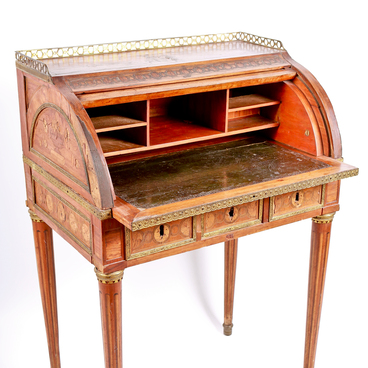In the ‘Kasimov District’ hall, one can see the interior of a peasant hut from the late 19th and early 20th centuries. It includes authentic household items, among which are kitchen utensils, donated to the museum by Kasimov residents. There is an old wooden rolling pin with carved handles among the exhibits.
Archaeologists have found that the Etruscans started using a stone cylinder for rolling dough about 3,000 years ago. They lived on the territory of the present day Italy and were the forerunners of Roman culture and civilization. After that, the rolling pin made its way into the inventory of other nations.
In Russia, the rolling pin was an irreplaceable tool in any housewife’s kitchen. With its help, they rolled out the dough for pies, dumplings and flatbread. The standard shape of the rolling pin was a long cylinder with a diameter of three to four centimeters with handles on both sides. However, there were models with only one handle or without handles, in which case the housewives also used them as a potato masher.
The rolling pins were made of wood, most often of linden. Unlike other types of wood, it did not crack, did not rot and did not change shape while drying. It could be soaked in water, and utensils made of this wood were sturdy. Cutting the rolling pin out was simple: first, the corners of wide sticks were rounded, and then, it was polished so that there were no hooks on the surface.
In the middle of the 18 century, in England, hollow glass rolling pins appeared. With their help, they not only rolled out the dough, but also stored inside spices, coffee and vinegar. Such items were often given as wedding gifts. In Russia, these utensils have not become widespread.
At the end of the 19th century, a new material, clay, was used in Europe for rolling pins. Unlike wood ones, the ceramic pins were easier and simpler to wash. Later, the design was improved, and rotating rolling pins on a central rod appeared instead of the cast ones.
In today’s kitchen, there are rolling pins made of different materials: wood, metal, ceramic, silicone and plastic. There are also models that are empty inside — you pour warm water into them to roll out the dough better.
Archaeologists have found that the Etruscans started using a stone cylinder for rolling dough about 3,000 years ago. They lived on the territory of the present day Italy and were the forerunners of Roman culture and civilization. After that, the rolling pin made its way into the inventory of other nations.
In Russia, the rolling pin was an irreplaceable tool in any housewife’s kitchen. With its help, they rolled out the dough for pies, dumplings and flatbread. The standard shape of the rolling pin was a long cylinder with a diameter of three to four centimeters with handles on both sides. However, there were models with only one handle or without handles, in which case the housewives also used them as a potato masher.
The rolling pins were made of wood, most often of linden. Unlike other types of wood, it did not crack, did not rot and did not change shape while drying. It could be soaked in water, and utensils made of this wood were sturdy. Cutting the rolling pin out was simple: first, the corners of wide sticks were rounded, and then, it was polished so that there were no hooks on the surface.
In the middle of the 18 century, in England, hollow glass rolling pins appeared. With their help, they not only rolled out the dough, but also stored inside spices, coffee and vinegar. Such items were often given as wedding gifts. In Russia, these utensils have not become widespread.
At the end of the 19th century, a new material, clay, was used in Europe for rolling pins. Unlike wood ones, the ceramic pins were easier and simpler to wash. Later, the design was improved, and rotating rolling pins on a central rod appeared instead of the cast ones.
In today’s kitchen, there are rolling pins made of different materials: wood, metal, ceramic, silicone and plastic. There are also models that are empty inside — you pour warm water into them to roll out the dough better.

